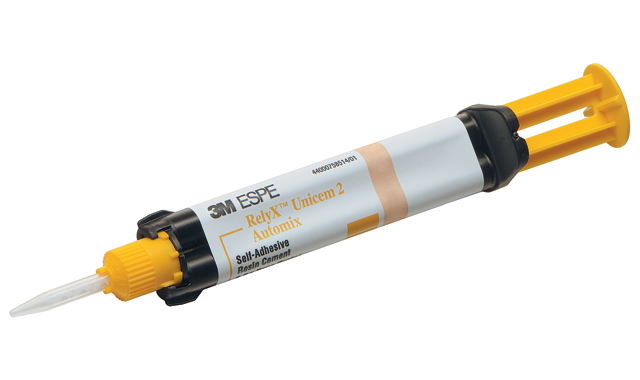How RelyX Unicem 2 creates predictable results for full-coverage crowns
Why one clinician prefers using this self-adhesive resin cement over others.

Dr. John Weston, DDS, FAACD, has been practicing for nearly three decades and for a little more than half of that time, he has been using RelyX™ Unicem 2 Self-Adhesive Resin Cement from 3M. As an early adopter, he recalls when it came in a capsule that you mixed in an amalgamator. While the delivery system has changed over the years, Dr. Weston says the need for an adhesive to hold full-coverage crowns and work in areas with short vertical height of preparations hasn’t.
“Previous to Unicem 2, in my experience, you had to use adhesive techniques, usually etching and then placing adhesives by treating the surfaces of both the crown and the tooth. What Unicem 2 did was eliminate the need for those steps and give you the adhesive qualities with just a single step,” he says.
Unicem 2’s elimination of surface preparations and multiple steps streamlined and simplified the process for Dr. Weston. It also created a more predictable outcome. Dr. Weston says he likes how using Unicem 2 helps to avoid mistakes.
More from the author: 10 ways lasers can make your practice money right now
“There are fewer chances of doing something wrong, missing a step or not doing a step exactly right. This is important for the assistants and doctors as well,” he says.
One of the reasons dentists utilize adhesive dentistry is to properly seal the tooth and avoid sensitivity for patients. Dr. Weston explains that Unicem 2 is an adhesive cement with good sealing properties, which leads to excellent patient response.
“I don’t think the patient cares what kind of cement you use; they just want it to be easy, comfortable and have no sensitivity in their tooth,” Dr. Weston says.
Dr. Weston knows a common problem with cements is that they can be difficult and time-consuming to clean up. Early on, his practice experienced challenges cleaning up Unicem 2. Now, he uses the Elipar™ Curing Light’s one-second tack feature to initiate the cure on the excess cement on buccal and lingual, enabling him to “pop it right off.” However, he recommends curing for no longer than one second.

“Don’t over cure it. If you spot tack longer and accidentally cure for five or 10 seconds, it’s going to be very difficult to remove,” he explains. “Also, if using a self-cure technique, don’t start cleaning it before it’s starting to set because that can be messy. I hear about people blowing air through the proximal contacts and then it sprays everywhere. It can be a real mess.”
Once you have removed the excess, Dr. Weston says to cure for another 20 seconds on buccal and lingual for the final cure or, if time allows, let it completely self-cure for five minutes.
Another common concern about self-adhesive cements is that they are not as strong as fourth- or fifth-generation bonding agents with multi-step systems. While that is true, Dr. Weston says that isn’t a fair comparison. No self-adhesive resin cement will have the same bond strength as those products by the nature of their one-step procedure. However, when comparing Unicem 2 to a traditional cement or to a resin-modified glass ionomer cement for full-coverage crowns or in areas where you have a short vertical height for preparations, Unicem 2 has superior advantages.
“That’s why people get confused and say, ‘It doesn’t have great adhesion.’ Well, it does compared to other one-step cements. You have to qualify what you are comparing it to,” he says. “The bond strengths are plenty reliable to the situations we are using it for, which is typically full-coverage crowns. We would not use this cement for ceramic veneers however.”
Dr. Weston also addresses the discussion regarding Unicem 2’s lack of fluoride release, a feature found in resin-modified glass ionomer cements. He asserts that a well-fitting restoration with a proper seal doesn’t need to rely on fluoride release. Moreover, research shows that resin-modified glass ionomer cements release very little fluoride at the margin. As a result, Dr. Weston believes the benefits of working with Unicem 2 outweigh any advantages resulting from fluoride release, especially in cases where you have short vertical height preparations.
Trending article: Why cosmetic dentistry matters to every practice
“If you have a crown that has a short vertical height, you likely would not use a resin-modified glass ionomer because it’s not strong enough. Now, you find yourself using a different cement that the doctor and assistant are not as familiar with,” he explains. “Unicem 2 allows you to use one cement for everything and have the adhesion you need for the very short vertical height preparations that traditional cements don’t offer.”
Dr. Weston appreciates the fact that using Unicem 2 for all full-coverage restorations, whether they are metal, pressed-ceramics or zirconia, means they only need to order one material. They don’t have multiple materials in the drawer, resulting in a streamlined chairside process for the dental staff.
“They know what to put out when we have the full-coverage crowns,” he says. “We can deliver crowns efficiently, fast and predictably. And we have reliability. You don’t have to worry about things coming off or failures. It solves a lot of problems for us.”